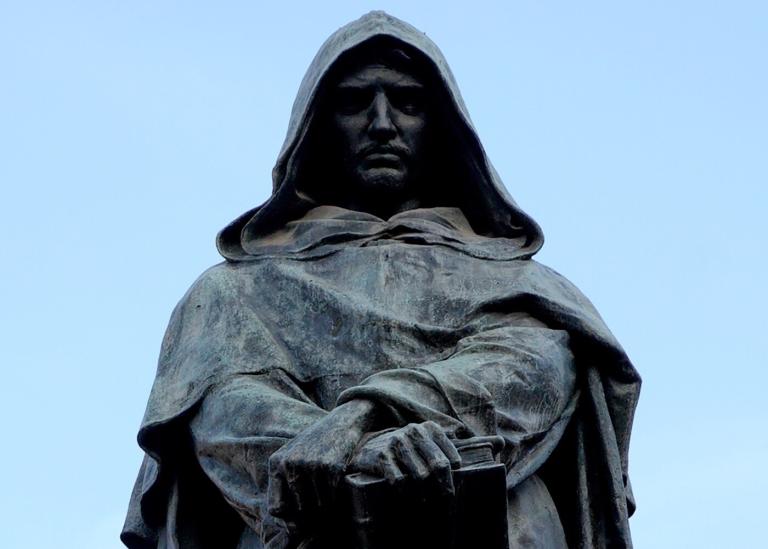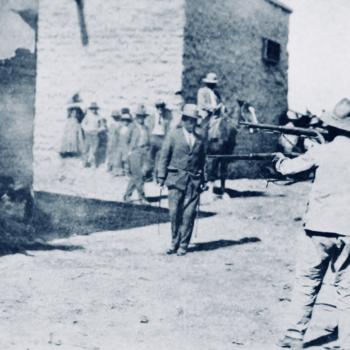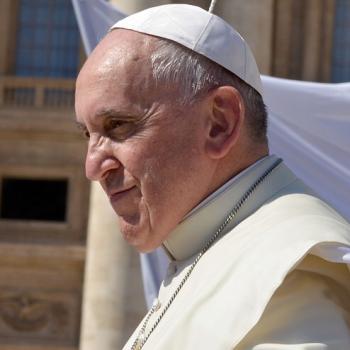
Giordano Bruno, by Ettore Ferrari (public domain)
Earlier this month, on the 7th, someone named Hrafnkell Haraldsson at Politicus USA had a wild fit of pique over all the objections to President Obama’s recent remarks at the National Prayer Breakfast. I am not going to go into that particular debate again; I have already done so here and here. But I do find it interesting that Mr. Haraldsson would portray the criticism as coming from Fox News and the right, since Andrea Mitchell and Lawrence O’Donnell, both of MSNBC, also took issue with what Mr. Obama said. How embarrassing for you when your narrative goes amiss like that.
Be that as it may, Mr. Haraldsson uses the occasion of his post to flail his rhetorical arms against three supposed outrages of Catholic history.
- When the Crusaders conquered Jerusalem in 1099, they slaughtered the enemy so brutally that people were “up to their ankles” in blood.
- During the Inquisition, in 1600, the Church burned Giordano Bruno at the stake because he did not believe that the sun revolved around the earth.
- Pope Nicholas V’s papal bull Dum Diversas (1452) permitted slavery against Muslims and other pagans.
As usual, claims like these contain much myth, as well as a lot of half-truth; they also lack any meaningful context. For that reason, I am going to spend the next few posts separating truth from fiction on these points. I will start, in this post, with some background to put the Inquisition into its real context. Then, in the next post, I will talk about what is and is not true in the case of Giordano Bruno.
***
The first thing we must keep in mind, before we can talk about specific cases, is why anyone burned heretics, or otherwise put them to death, at the time. In an article for Crisis, in 2011, Dr. Thomas F. Madden, historian and expert in the Crusades, gives us some insight into the question. Here is what he says.
It’s worth pointing out that the medieval world was not the modern world. For medieval people, religion was not something one just did at church. It was their science, their philosophy, their politics, their identity, and their hope for salvation. It was not a personal preference but an abiding and universal truth. Heresy, then, struck at the heart of that truth. It doomed the heretic, endangered those near him, and tore apart the fabric of community. … The modern practice of universal religious toleration is itself quite new.
“The medieval world was not the modern world”; it seems trite and condescending to say that. But it is very important, if we are going to talk about the Inquisition, to understand the world of thought that actually existed at the time. It was not our own. At a time when Europe was universally Christian, religion was the one real stabilizing factor against civil unrest. For that reason, people commonly accepted that heresy was a threat to the security of the state. It was not mere religious error, or difference of opinion. It was, in fact, treason. Dr. Madden tells us why.
[K]ingship was God-given, thus making heresy an inherent challenge to royal authority. Heretics divided people, causing unrest and rebellion. No Christian doubted that God would punish a community that allowed heresy to take root and spread.
Think about that for a moment. If the state is founded in religion—and a state not founded in religion would have been an utterly foreign concept—a heretic had the potential to divide the state. Heresy could, and did, lead to civil unrest and civil war. So it was a very serious point in that way alone.
But there was more to it than that. In Summa Theologica, St. Thomas Aquinas tells us the other threat that a heretic posed. He brings it up during his argument in favor of the death penalty for heretics.
With regard to heretics two points must be observed: one, on their own side; the other, on the side of the Church. On their own side there is the sin, whereby they deserve not only to be separated from the Church by excommunication, but also to be severed from the world by death. For it is a much graver matter to corrupt the faith which quickens the soul, than to forge money, which supports temporal life. Wherefore if forgers of money and other evil-doers are forthwith condemned to death by the secular authority, much more reason is there for heretics, as soon as they are convicted of heresy, to be not only excommunicated but even put to death.
To embrace or teach heresy was to put not only your own soul, but the souls of others too, in danger of Hell. The crime of murder was punished by death, and murder kills only the body. But heresy kills the soul, which is a much graver offense. Jesus said, “And fear not them which kill the body, but are not able to kill the soul; but rather fear him which is able to destroy both soul and body in Hell” (Matt. 10:28). We should fear a heretic more than a murderer.
In Tract 11 on the Gospel of John, St. Augustine says of the Donatists:
They slay souls, they suffer in body; they cause everlasting deaths, and yet they complain that they themselves suffer temporal deaths. (§15)
To put to death a heretic, from this point of view, was a moral good because it saved souls who might otherwise be led into mortal error. If a heretic would not repent, he should not be able to lead others to Hell with him. So people believed that heresy was a threat to both the security of the state and the eternal welfare of the human soul.
Now, that is not how modern society sees things, in an age of religious pluralism and tolerance. And for a number of very good reasons, few of us would want to return to a time when the state and the Church got involved in each other’s affairs. Even from a religious point of view, that rightly strikes us as a very bad idea. We have learned from the past. Nor would any of us want to go back to burning criminals of any kind at the stake. No one defends that.
But as a first principle, we must keep in mind that we are speaking of a time when ideas such as those we hold now were quite foreign. They were still several centuries off. We must not permit ourselves, however good it might seem, however well it might make us think of ourselves, to judge an earlier age based on an ethos that was alien to them.
***
The second thing to keep in mind is that it was by no means the Church that put heretics to death. Mr. Haraldsson says, in a pointed and angered way, that the Church killed Bruno, but that is not so. The State put heretics to death. The Church could only excommunicate you. The Church could abjure you to repent. She could try to bring you back to the faith. But she had no power to exercise civil justice.
Now, it is very true—and this is a case in point of how the truth is more complex than the myths make it out to be—that the State did so with the Church’s assurance (1) that God had given it the authority to, and (2) it is not a mortal sin to execute those guilty of a capital crime.
On the first point, St. Thomas Aquinas argues from Scripture that the state has authority, from God, “to execute wrath upon him that doeth evil.”
He who takes vengeance on the wicked in keeping with his rank and position does not usurp what belongs to God but makes use of the power granted him by God. For it is written (Romans 13:4) of the earthly prince that “he is God’s minister, an avenger to execute wrath upon him that doeth evil.” If, however, a man takes vengeance outside the order of divine appointment, he usurps what is God’s and therefore sins.
No one, not even now, doubts the point that Aquinas makes here. The state alone has the authority to punish crime. No one else can take the law into his own hands, not even the Church. The power to put a man to death is the state’s. That was how the Church understood Rom. 13:4. The only difference in this case is that heresy, in the Middle Ages, was a crime. In fact, it was a capital crime. And whether we want to admit it or not, our belief that the State, of right, has authority to punish criminals is biblical in origin.
On the second point, Pope Innocent III (1198-1216), in prescribing terms of reconciliation for the Waldensians, included these words.
We conclude that the secular power can without mortal sin impose a judgment of blood provided the punishment is carried out not in hatred but with good judgment, not inconsiderately but with mature deliberation.
So the State, according to Innocent III—only the State—can impose the death penalty. But the Church intervenes (note this, Mr. Haraldsson) to limit the conditions by which it can do so, on pain of mortal sin. The State must act with judgment and deliberation in rooting out where guilt really does exist. It must not use its power merely for whim, or for its own sake, or so that one faction may retain control.
Far from the Church putting heretics to death, it left that power to the State and said that there were limits to it. The State could execute only in the pursuit of justice.
***
But what often happened, in the case of heresy, was that the state ended up executing people who were wholly orthodox. One reason for this is that secular authorities did not have the right training to make a judgment like that. Also, at a time when large-scale heresies like Catharism were a real threat, mobs would often burn accused heretics without so much as a trial. The Catholic Encyclopedia tells us of a few such cases.
In 1114 several heretics who had been captured in the Diocese of Soissons were seized and burned by the populace while their case was under discussion at the Council of Beauvais. Others were either threatened with, or actually met a similar fate at Liège in 1144; some of them were spared owing only to the energetic intervention of the local bishop, Adalbero II.
In an effort to curb such abuses and ensure that only those with the training to do so would investigate charges of heresy, Pope Gregory IX, in 1231, appointed the first Inquisitors. He took them from the Franciscans and Dominicans, who had the right learning for the task. (Later, the Church would call on Jesuits like St. Robert Bellarmine.) Manuals such as this one, written by Bernard Gui, were provided so that the accused would be treated fairly and equally. They also helped to ensure uniform practice.
According to the 19th century historian Reuben Parsons, in Some Lies and Errors of History, the whole point of Inquisition was to make sure that those accused were secure in their rights and given the chance to repent first. The Church required basic rules of fair play.
- Inquiry would be by priests who were “more learned and less harsh than civil authorities.”
- Inquisitors would invite repentance before a suspect was arrested.
- Those who did repent would be pardoned.
- No anonymous person could accuse someone of heresy.
- The accused were to be given a certain period of time to present themselves for trial.
- Witnesses were to be heard before a notary and two priests.
- The accused were allowed a procurator, or defense attorney.
Historian John Tedeschi confirms that modern scholars all know this to have been the case.
[I]n trials conducted under the Inquisition’s jurisdiction, accusers had to make their depositions under oath. … [T]he arraigned had the benefit of a defense attorney; transcripts of the proceedings were provided to prisoners in writing; and an appropriate interval [was] allowed for the preparation of counterarguments and the summoning of friendly witnesses. Judicial torture (universally practiced by all courts in Europe) could be applied only after the defense had made its case and where the indicia (the evidence of heresy) were compelling. Appeals were also permitted and were made regularly to a higher court, namely the Supreme Congregation in Rome. First offenders were dealt with much more leniently than recidivists. A sentence to carcere perpetuo, “life imprisonment,” by the Holy Office meant parole after a few years (generally three) subject to good behavior; house arrest, which often included permission to work outside one’s home, was frequently imposed, especially given the lack of secure prisons outside Rome. Sentences pronounced by provincial tribunals were scrutinized by the Supreme Congregation of the Inquisition in Rome, and implausible confessions that contradicted the defendant’s testimony during the trial were unacceptable.
And in fact, as Dr. Madden tells us:
Secular rulers strongly supported the Inquisition because they saw it as an efficient way to ensure the religious health of their kingdoms. [And it helped keep the mob in check.] If anything, kings faulted the Inquisition for being too lenient on heretics.
That is because the concern of kings was with justice and order; and the concern of the Church was with mercy and regaining those who had embraced error. Gregory IX was of the view that heretics could be reconciled with the Church if they knew the truth. That was his primary objective. That is why the Church gave heretics more than one opportunity to recant. The Church acted out of love for souls, and a desire that all men know the truth. It acted to save lives, not to take them. It had no zeal for the rack or the post; that is a myth.
***
But history is complex, and no system is perfect; and there is no doubt that people made errors and did sinful things. The trial and execution of St. Joan of Arc is a case in point. First arrested in 1430, she was brought before the Inquisition entirely on political motivations arising out of the Hundred Years’ War. Cauchon, her accuser, had fought on the side of the English, and the official Inquistors were reluctant to proceed. This was a clear case where a military foe tried to use the Inquisition to achive a political end. When it did not go as he had hoped, he took matters into his own hands; and Joan was burned at the stake on May 30, 1431. A few years later, Joan’s mother petitioned the Inquisition to re-open her case; it reversed her condemnation on July 7, 1456.
But St. Joan’s case is, for that same reason, an example of why the Inquisition was needed and what it sought to avoid. In the context of the time, the state was going to execute heretics. That is just a fact about which there is no point in lashing ourselves into a fit of outrage. But what the Church did was to step in and say that the accused had rights, that they should have a trial; and a defense; and a chance to repent, avoid death, and return to the Church. They would have had none of these things had the Church ceded prosecution of heresy to the State and to mob rule. That some tried to get around it, or use it for their own ends, only shows that the Church had done the right thing.
“The simple fact,” Dr. Madden says, “is that the medieval Inquisition saved uncounted thousands of innocent … people who would otherwise have been roasted by secular lords or mob rule.” And it also, no doubt, helped to reconcile many with the Church. That is a real good.
So if we put the Inquisition in the context of the time, and clear away a lot of the myths that have grown up around it, we are in a better position to look into the case of Giordano Bruno. And that is what I will do in Part 2.












